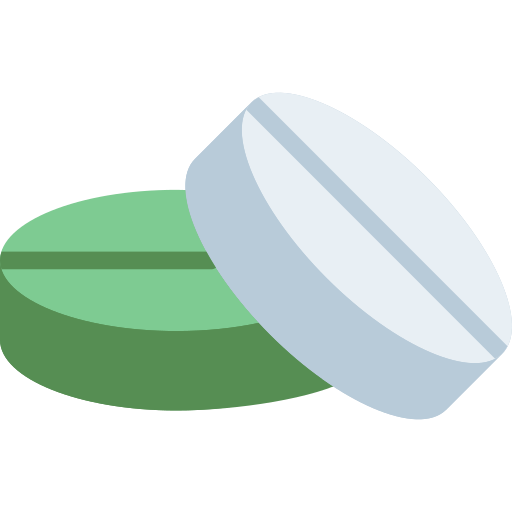
Product Details
Description
Strongyloidiasis of the intestinal tract: Ivermectin is indicated for the treatment of intestinal (i.e., nondisseminated) strongyloidiasis due to the nematode parasite Strongyloides stercoralis. This indication is based on clinical studies of both comparative and open-label designs, in which 64-100% of infected patients were cured following a single 200-mcg/kg dose of ivermectin. Onchocerciasis: Ivermectin is indicated for the treatment of onchocerciasis due to the nematode parasite Onchocerca volvulus. This indication is based on randomized, double-blind, placebo-controlled and comparative studies conducted in 1427 patients in onchocerciasis-endemic areas of West Africa. The comparative studies used diethylcarbamazine citrate (DEC-C).
It is contraindicated in patients who are hypersensitive to any component of this product.
Strongyloidiasis: In four clinical studies involving a total of 109 patients given either one or two doses of 170 to 200 mcg/kg of Ivermectin, the following adverse reactions were reported as possibly, probably, or definitely related to Ivermectin. Body as a whole: asthenia/fatigue (0.9%), abdominal pain (0.9%) Gastrointestinal: anorexia (0.9%), constipation (0.9%), diarrhea (1.8%), nausea (1.8%), vomiting (0.9%) Nervous System/Psychiatric: dizziness (2.8%), somnolence (0.9%), vertigo (0.9%), tremor (0.9%) Skin: pruritus (2.8%), rash (0.9%), and urticaria (0.9%). Onchocerciasis: arthralgia/synovitis (19.3%), axillary lymph node enlargement and tenderness (11.0% and 4.4%, respectively), cervical lymph node enlargement and tenderness (5.3% and 1.2%, respectively), inguinal lymph node enlargement and tenderness (12.6% and 13.9%, respectively), other lymph node enlargement and tenderness (3.0% and 1.9%, respectively), pruritus (27.5%), skin involvement including edema, papular and pustular or frank urticarial rash (22.7%), and fever (22.6%), abnormal sensation in the eyes, eyelid edema, anterior uveitis, conjunctivitis, limbitis, keratitis, and chorioretinitis or choroiditis. These have rarely been severe or associated with loss of vision and have generally resolved without corticosteroid treatment. The following adverse reactions have been reported since the drug was registered overseas: hypotension (mainly orthostatic hypotension), worsening of bronchial asthma, toxic epidermal necrolysis, and Stevens-Johnson syndrome.
Pregnancy Category C. Ivermectin does not appear to be selectively fetotoxic to the developing fetus. There are, however, no adequate and well-controlled studies in pregnant women. Ivermectin should not be used during pregnancy since safety in pregnancy has not been established. Nursing Mothers: Ivermectin is excreted in human milk in low concentrations. Treatment of mothers who intend to breast feed should only be undertaken when the risk of delayed treatment to the mother outweighs the possible risk to the newborn
Historical data have shown that microfilaricidal drugs, such as diethylcarbamazine citrate (DEC-C), might cause cutaneous and/or systemic reactions of varying severity (the Mazzotti reaction) and ophthalmological reactions in patients with onchocerciasis. These reactions are probably due to allergic and inflammatory responses to the death of microfilariae. Patients treated with Ivermectin for onchocerciasis may experience these reactions in addition to clinical adverse reactions possibly, probably, or definitely related to the drug itself. The treatment of severe Mazzotti reactions has not been subjected to controlled clinical trials. Oral hydration, recumbency, intravenous normal saline, and/or parenteral corticosteroids have been used to treat postural hypotension. Antihistamines and/or aspirin have been used for most mild to moderate cases. After treatment with microfilaricidal drugs, patients with hyperreactive onchodermatitis (sowda) may be more likely than others to experience severe adverse reactions, especially edema and aggravation of onchodermatitis. Rarely, patients with onchocerciasis who are also heavily infected with Loa loa may develop a serious or even fatal encephalopathy either spontaneously or following treatment with an effective microfilaricide. In these patients, the following adverse experiences have also been reported: back pain, conjunctival hemorrhage, dyspnea, urinary and/or fecal incontinence, difficulty in standing/walking, mental status changes, confusion, lethargy, stupor, or coma.
Pediatric Use: Safety and effectiveness in pediatric patients weighing less than 15 kg have not been established. Geriatric Use: Clinical studies of Ivermectin did not include sufficient numbers of subjects aged 65 and over to determine whether they respond differently from younger subjects.
Anthelmintic
Keep in a dry place, below 30°C. Protect from light. Keep out of the reach of children.
-
Support 24/7
Call us anytime -
100% Safety
Only secure payments